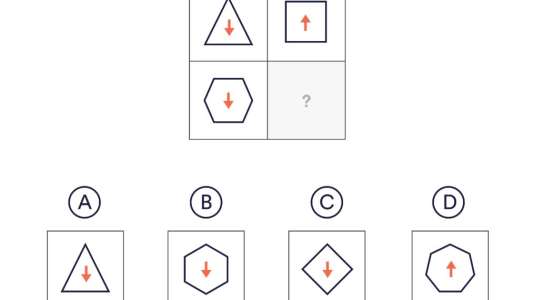Abstract reasoning tests are non-verbal and non-numerical, and are often seen to be a good indicator of general intelligence. They use shapes, diagrams and patterns to assess candidates’ abilities to solve problems and think laterally under time pressure.
Whether you’ve encountered a test like this before or not, it’s important to practice abstract reasoning tests to improve your speed, accuracy and confidence, before taking the test as part of a recruitment process.
On a more specific level, look for patterns, break shapes down into their individual parts and jot anything down you think might be significant.
Remember to read the questions thoroughly too, so you’re answering what’s asked of you, not what you assume you’re being asked to do. Below are ten further tips that may help you with abstract reasoning assessments.
Ten tips to prepare for abstract reasoning tests
Step 1: Understand the format
Understanding the format, and what the questions are really asking, is crucial if you want to do the best you can on the test.
Once you’ve worked through a few mock tests this will start to become much clearer, but it’ still essential to read every question thoroughly on the day of the test.
Step 2: Develop your own technqique
While it’s important to practice the tests themselves, there are plenty of other ways you can sharpen your skills.
Whether it’s playing puzzle-based computer games, challenging a friend to an abstract challenge or finding ways to learn through your everyday experiences, it can be really beneficial to hone your skills in different ways.
Step 3: Identify the pattern first
There are many ways you can do this.
Firstly, just try and look at the shapes or patterns in front of you and see if the answer is obvious, or can be easily worked out.
Keep a mental checklist in place: looking at size, number and shape is a good starting point. You can run through these first to see if anything jumps out at you.
If this doesn’t work, try to look for clues in the answer. There are often similar themes (such as lots of one particular shape) that can help you to work out the answer more quickly, or at least discount a few options.
If you’ve tried all of the above and are still not sure, you’ve probably garnered enough information to make an educated guess.
Step 4: Avoid distractors in the patterns
One of the most challenging aspects of the abstract reasoning test is the number of distractors in the answer options that are there to try and make things harder.
A common distractor is using colour to confuse you, when you should be concentrating on shapes.
The best way to avoid distractors is to break down the potential answers into their single parts. This means looking at things like shape, size, orientation, positioning, colour, symmetry and direction one piece at a time.
This is obviously challenging to do within a tight time limit, which is why pre-practice is so important.
Step 5: Practice tricky questions
Practicing past abstract reasoning tests really is the single best way to improve.
Once you’ve worked through a few and made sure to go over your answers, it’ll probably become clear to you which areas you struggle with — this is where you need to focus your attention.
The more you practice the areas you struggle with, the more you’ll really feel the benefits.
Step 6: Track your progress when practicing
This is a great way to motivate yourself and see self-improvement.
Why not attach tangible rewards to improved scores? It can be really helpful to have something to visualise and work towards, and makes getting better feel even sweeter.
Step 7: Allocate time to each question
This is the best way to ensure you don’t get stuck on a tricky problem at the expense of questions you may find easier further on in the test.
At the beginning of the test, make a mental note of how long you’ll have on each question and try to stick to it.
If there’s time at the end, you can always revisit anything you found challenging or didn’t get to finish.
Step 8: If you get stuck, move on
It can be hard to do this, as it’s natural to want to stick with something until you’re confident you’ve got it right. But if you spend too long on one problem, you may not have time to answer easier ones further into the test.
Step 9: Build confidence
The best way to increase your confidence is to practice as many abstract reasoning tests as you can, and focus on the areas you find particularly challenging.
Not only will doing this help your skills to improve, you’ll also gain confidence just by familiarising yourself with the format of the questions.
Step 10: Don't give up
Tests are stressful, and if you feel like it’s not going well it can be tempting to give up. But if you’ve practiced and prepared beforehand, there’s every chance you’ll be able to work out the answer.
Take a deep breath, read the question again, and if you really can’t work out the answer, make an educated guess.

